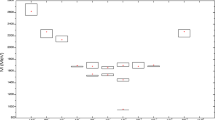Abstract
Baryons made of two or three heavy quarks can be described in the modern language of non- relativistic effective field theories. These, besides allowing a rigorous treatment of the systems, provide new insight in the nature of the three-body interaction in QCD.
Similar content being viewed by others
References
Brambilla N., Pineda A., Soto J., Vairo A.: Effective field theories for heavy quarkonium. Rev. Mod. Phys. 77, 1423 (2005) arXiv:hep-ph/0410047
Brambilla N., Rösch T., Vairo A.: Effective field theory Lagrangians for baryons with two and three heavy quarks. Phys. Rev. D 72, 034021 (2005) arXiv:hep-ph/0506065
Fleming S., Mehen T.: Doubly heavy baryons, heavy quark-diquark symmetry and NRQCD. Phys. Rev. D 73, 034502 (2006) arXiv:hep-ph/0509313
Savage M.J., Wise M.B.: Spectrum of baryons with two heavy quarks. Phys. Lett. B 248, 177 (1990)
Takahashi T.T., Matsufuru H., Nemoto Y., Suganuma H.: The three-quark potential in the SU(3) lattice QCD. Phys. Rev. Lett. 86, 18 (2001) [hep-lat/0006005]
Takahashi T.T., Matsufuru H., Nemoto Y., Suganuma H.: Detailed analysis of the three quark potential in SU(3). Phys. Rev. D 65, 114509 (2002) [hep-lat/0204011]
Yamamoto A., Suganuma H., Iida H.: Heavy-heavy-light quark potential in SU(3) lattice QCD. Phys. Lett. B 664, 129 (2008) arXiv:0708.3610 [hep-lat]
Yamamoto A., Suganuma H., Iida H.: Lattice QCD study of the heavy-heavy-light quark potential. Phys. Rev. D 78, 014513 (2008) arXiv:0806.3554 [hep-lat]
Najjar, J., Bali, G.: Static-static-light baryonic potentials. arXiv:0910.2824 [hep-lat]
Brambilla N., Pineda A., Soto J., Vairo A.: The QCD potential at O(1/m). Phys. Rev. D 63, 014023 (2001) arXiv:hep-ph/0002250
Pineda, A., Vairo, A.: The QCD potential at O (1/m 2): Complete spin dependent and spin independent result. Phys. Rev. D 63, 054007 (2001). [Erratum-ibid. D 64, 039902 (2001)], arXiv:hep-ph/0009145
Brambilla N., Pineda A., Soto J., Vairo A.: The (mΛQCD)1/2 scale in heavy quarkonium. Phys. Lett. B 580, 60 (2004) arXiv:hep-ph/0307159
Koma Y., Koma M., Wittig H.: Nonperturbative determination of the QCD potential at O(1/m). Phys. Rev. Lett. 97, 122003 (2006) arXiv:hep-lat/0607009
Koma Y., Koma M.: Spin-dependent potentials from lattice QCD. Nucl. Phys. B 769, 79 (2007) arXiv:hep-lat/0609078
Koma Y., Koma M., Wittig H.: Relativistic corrections to the static potential at O(1/m) and O(1/m 2). PoS LAT2007, 111 (2007) arXiv:0711.2322 [hep-lat]
Koma, Y., Koma, M.: Scaling study of the relativistic corrections to the static potential. arXiv:0911.3204 [hep-lat]
Brambilla, N., Garcia i Tormo, X., Soto, J., Vairo, A.: Precision determination of \({r_0\Lambda_{\rm \overline{MS}}}\) from the QCD static energy. arXiv:1006.2066 [hep-ph]
Brambilla N., Garciai Tormo X., Soto J., Vairo A.: The QCD static energy at NNNLL. Phys. Rev. D 80, 034016 (2009) arXiv:0906.1390 [hep-ph]
Brambilla N., Ghiglieri J., Vairo A.: The three-quark static potential in perturbation theory. Phys. Rev. D 81, 054031 (2010) arXiv:0911.3541 [hep-ph]
Mattson M. et al.: SELEX Collaboration: First observation of the doubly charmed baryon \({\Xi_{cc}^+}\). Phys. Rev. Lett. 89, 112001 (2002) arXiv:hep-ex/0208014
Ocherashvili A. et al.: SELEX Collaboration: Confirmation of the double charm baryon \({\Xi_{cc}^+(3520)}\) via its decay to p D + K −. Phys. Lett. B 628, 18 (2005) arXiv:hep-ex/0406033
Grozin A.G., Marquard P., Piclum J.H., Steinhauser M.L.: Three-loop chromomagnetic interaction in HQET. Nucl. Phys. B 789, 277 (2008) arXiv:0707.1388 [hep-ph]
Lewis R., Woloshyn R.M.: Bottom baryons from a dynamical lattice QCD simulation. Phys. Rev. D 79, 014502 (2009) [arXiv:0806.4783 [hep-lat]]
Hübner K., Karsch F., Kaczmarek O., Vogt O.: Heavy quark free energies for three quark systems at finite temperature. Phys. Rev. D 77, 074504 (2008) arXiv:0710.5147 [hep-lat]
Author information
Authors and Affiliations
Corresponding author
Additional information
“Relativistic Description of Two- and Three-Body Systems in Nuclear Physics”, ECT*, October 19-23 2009.
Rights and permissions
About this article
Cite this article
Vairo, A. Effective Field Theories for Baryons with Two- and Three-Heavy Quarks. Few-Body Syst 49, 263–268 (2011). https://doi.org/10.1007/s00601-010-0107-7
Received:
Accepted:
Published:
Issue Date:
DOI: https://doi.org/10.1007/s00601-010-0107-7




